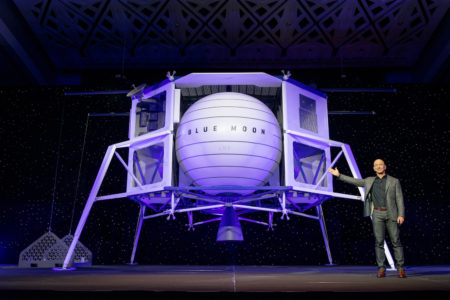May 10, 2019 – Yesterday in a press conference, Jeff Bezos, CEO of Amazon and Blue Origin made a once in a Blue Moon announcement. He talked about Blue Origin’s offer to NASA of a lunar lander capable of delivering 3.6 to 6.5 tons to support the American administration’s 2024 goal to return to the Moon.
But before Bezos described his Blue Origin technology, he took us on a journey of discovery about his vision for humans in space, one far different from that conceived by his rocket company rival Elon Musk at SpaceX. Bezos sees humans in space and not on Mars, or any other planetary real estate. To him it makes little sense colonizing the Moon and Mars which are both unsuitable for life unless it is enclosed in a controlled environment. And then those humans living and working on the Moon or Mars would have to contend with low gravity environments for which our bodies are not designed. Instead, Bezos envisions manufactured worlds designed to provide internal Earth-equivalent gravity environments and in parking orbits near-Earth. He sees artificial habitats designed to be zero-gravity play environments or to be replicas of Earth cities, or some of our wild places. Bezos sees all of the heavy industry moving off Earth to space environments allowing us to make our planet a much healthier environment.
But this vision cannot happen in the space we know of today. The space of NASA, Roscosmos, ESA and other national space agencies is an expensive place. There is little infrastructure in place today to get there. Bezos sees the role of Blue Origin in achieving the vision as being equivalent to building a road that is easily accessible, and that is inexpensive. And once the road is built with highly reusable launch vehicles we can then move to the next stage.
That stage is all about harnessing space resources with the Moon as Bezos’ objective. And that is where Blue Moon comes in, a lander that can deliver a wide variety of payloads to the lunar surface. The stretched version of Blue Moon would include an ascent module for human crew descent and ascent from the lunar surface.
Blue Moon is configured to handle a wide range of payloads as well as act as a launch platform for micro-satellites in lunar orbit. It uses a navy-inspired davit system for despatching cargo from its payload surface to the lunar surface. It can also be topped with an attachable, pressurized vessel which can carry astronauts to the surface, and then act as an ascent vehicle to return humans to lunar orbit. Bezos plans to use Blue Origin’s second generation rocket, New Glenn, which will make its first flight in 2021, to be the launch vehicle for Blue Moon.
Blue Moon will use the hydrogen-fueled BE-7 rocket engine which has been under development at Blue Origin for the last three years. Unlike the Apollo Lunar Module, which was powered by hypergolic rocket engines, the Blue Moon is powered by Blue Origin’s liquid hydrogen-fueled BE-7 engine, the evolution of the BE series of engines designed from 3D-printed parts and built for reuse and very precise throttling capability to support soft landings and refiring. The BE-7 will begin full testing with a hot fire planned for this summer.
The BE-7 will burn liquid hydrogen. And once Blue Moon is on the lunar surface it will be powered by hydrogen fuel cells. In using hydrogen for lunar activities, Blue Origin has made a conscious choice since the first mining activity on the Moon will be the harvesting of water which when broken down will provide oxygen and hydrogen, the former for life support and as an oxidizer, and the latter useful for topping up both the fuel cells and refilling the BE-7 engine tank. The BE-7 engine generates 40 KiloNewtons (10,000 pounds) of thrust.
NASA continues to work on the details of its return to the Moon initiative. With Blue Moon, it adds another commercial provider to the several contenders for the contract to build including Lougheed Martin, Boeing, and SpaceX. The 2024 date is a mere five years in the future. NASA took six years to develop Apollo before the first lunar landing in 1969. If done right, there should be plenty of time to make that 2024 date.
















